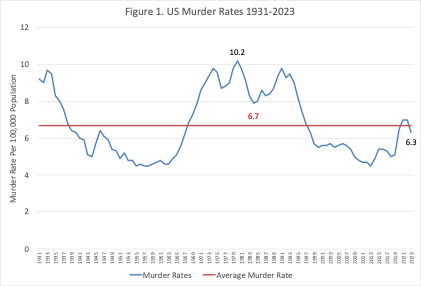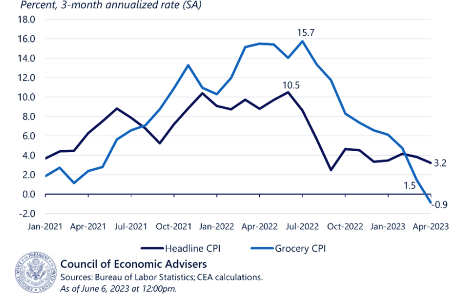Crime Data Analysis September 28, 2023
As summer concludes, it’s increasingly clear that there was no so-called crime wave. The FBI reported that over-all crime dropped by 10% in the first quarter of 2023 as compared to the first quarter in 2022. In particular, the number of murders dropped by 17%. A national expert in criminal justice data, Jeff Asher, published a piece about it in The Atlantic. Looking at the first six months of 2023 as compared to 2022, the murder rate fell by double digits across America. It was “astonishing”, he wrote.
Yet with few exceptions the media either seems unaware or is uninterested in these downward murder rates because they don’t tend to grab readers’ attention in quite the same way that rising ones do. Drumbeats of murder stories continued in cities across the country. Reporting on downward trends was rarer. The New York Times did run a story citing the drop in shootings in New York City. The 25 percent fall is in line with other falls across the country. But this is an important story to tell as it has significant consequences for the public’s perception of how safe criminal justice reforms are like the Safety and Justice Challenge, a project of the John D. and Catherine T. MacArthur Foundation, that have significantly reduced jail populations across the country over recent years.
First let’s examine murder rates and why they increased in 2020 and are declining again. Historically, murder rates since 1931 have ranged from 10 to 5 per 100,000 population (see graph below, figure 1). The historic average is 6.7. So, the recent increases since 2020 actually reflect the historic average. Assuming the first six months of 2023 hold, the 2023 rate will dip down to 5.7 – well below the historic average.

We have developed a statistical model that accurately projects future crime rates. The model uses several demographic and economic factors that have been shown to be associated with changes in the crime rates.
One of the most important factors in the model is the inflation rate—as the inflation rate goes up and down, so too does the murder rate. There is a lagged effect, as it takes a little time for lower and higher inflation rates to impact people’s behavior.
When COVID-19 hit in 2020 there was an associated increase in the inflation rate reaching a high of over 9 percent (see graph below, figure 2). Not unexpectedly, the crime rates soon began to climb, although never coming close to the high rates of the 1990s when inflation was over ten percent. Today the inflation rate has dropped to 3 percent and so, too, the crime rate has begun to recede. Assuming the inflation rate continues to decline and other factors in our model do not change, crime rates and murders will continue to slowly decline.

Unfortunately, the media and other pundits wrongfully assigned the post-COVID-19 murder rate increases to progressive criminal justice reforms. Bail reform, lenient prosecutors and judges, and police reforms were all cast as the causes of increases in homicides. Yet how does one explain why homicides are now declining with these same reforms still in place?
The tone of crime coverage is important because it shapes public sentiment which in turn can shape public policy. Polls show that the public believes that crime is up, even when the data above show it is down. As sociologists W. I. Thomas and Dorothy Thomas stated almost a century ago, “If men define situations as real, they are real in their consequences.”
Public sentiment influences policy makers and their decisions to support or resist criminal justice reforms. The research is very clear that we can reduce jail populations and keep communities safe. But when the media tends to report more on rising and not falling crime rates, it creates significant challenges.
While much has been achieved with the Safety and Justice Challenge, there are signs that some of these results could slip away in part because of erroneous public perceptions and the lack of media reporting about declining crime trends. It will be important for SJC sites, which are showing the same crime drops, to make their case to the public and the local media about what is really going on.
Table 1. SJC Major City Murders 2022 vs 2023
| City | 2023 | 2022 | Change | % Change | As Of |
| Charleston, SC | 5 | 4 | 1 | 25% | 10-Jul-23 |
| Charlotte, NC | 24 | 19 | 5 | 26% | 31-Mar-23 |
| Chicago, IL | 317 | 345 | -28 | -8% | 9-Jul-23 |
| Houston, TX | 142 | 186 | -44 | -24% | 31-May-23 |
| Las Vegas, NV | 67 | 67 | 0 | 0% | 7-Jul-23 |
| Los Angeles, CA | 145 | 187 | -42 | -22% | 1-Jul-23 |
| Memphis, TN | 172 | 123 | 49 | 40% | 6-Jul-23 |
| Milwaukee, WI | 80 | 114 | -34 | -30% | 11-Jul-23 |
| Nashville, TN | 60 | 56 | 4 | 7% | 8-Jul-23 |
| New Orleans, LA | 127 | 154 | -27 | -18% | 12-Jul-23 |
| New York, NY | 212 | 231 | -19 | -8% | 9-Jul-23 |
| North Las Vegas, NV | 6 | 12 | -6 | -50% | 31-May-23 |
| Philadelphia, PA | 203 | 281 | -78 | -28% | 9-Jul-23 |
| Pittsburgh, PA | 16 | 18 | -2 | -11% | 31-Mar-23 |
| Portland, OR | 36 | 39 | -3 | -8% | 31-May-23 |
| San Francisco, CA | 28 | 26 | 2 | 8% | 9-Jul-23 |
| Spokane, WA | 5 | 9 | -4 | -44% | 8-Jul-23 |
| St Louis, MO | 82 | 86 | -4 | -5% | 30-Jun-23 |
| Toledo, OH | 17 | 28 | -11 | -39% | 1-Jul-23 |
| Totals | 1,744 | 1,985 | -241 | -12% |


